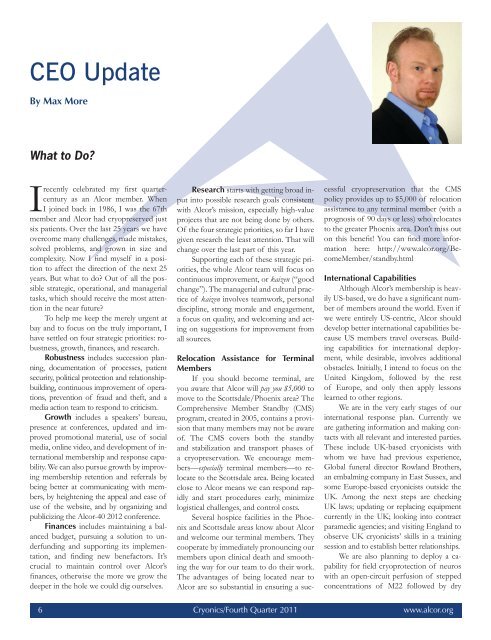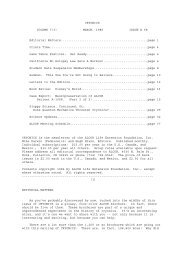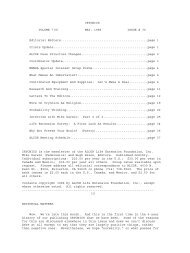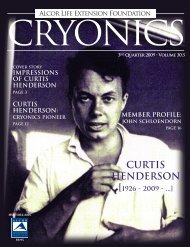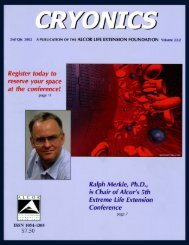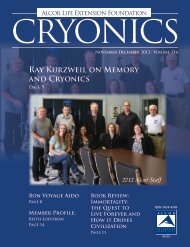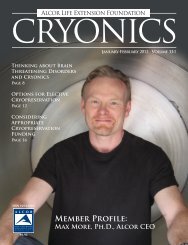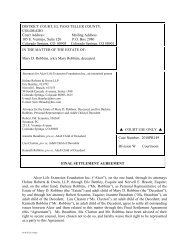Robert Ettinger - Alcor Life Extension Foundation
Robert Ettinger - Alcor Life Extension Foundation
Robert Ettinger - Alcor Life Extension Foundation
Create successful ePaper yourself
Turn your PDF publications into a flip-book with our unique Google optimized e-Paper software.
CEO Update<br />
By Max More<br />
What to Do?<br />
I<br />
recently celebrated my first quartercentury<br />
as an <strong>Alcor</strong> member. When<br />
I joined back in 1986, I was the 67th<br />
member and <strong>Alcor</strong> had cryopreserved just<br />
six patients. Over the last 25 years we have<br />
overcome many challenges, made mistakes,<br />
solved problems, and grown in size and<br />
complexity. Now I find myself in a position<br />
to affect the direction of the next 25<br />
years. But what to do? Out of all the possible<br />
strategic, operational, and managerial<br />
tasks, which should receive the most attention<br />
in the near future?<br />
To help me keep the merely urgent at<br />
bay and to focus on the truly important, I<br />
have settled on four strategic priorities: robustness,<br />
growth, finances, and research.<br />
Robustness includes succession planning,<br />
documentation of processes, patient<br />
security, political protection and relationshipbuilding,<br />
continuous improvement of operations,<br />
prevention of fraud and theft, and a<br />
media action team to respond to criticism.<br />
Growth includes a speakers’ bureau,<br />
presence at conferences, updated and improved<br />
promotional material, use of social<br />
media, online video, and development of international<br />
membership and response capability.<br />
We can also pursue growth by improving<br />
membership retention and referrals by<br />
being better at communicating with members,<br />
by heightening the appeal and ease of<br />
use of the website, and by organizing and<br />
publicizing the <strong>Alcor</strong>-40 2012 conference.<br />
Finances includes maintaining a balanced<br />
budget, pursuing a solution to underfunding<br />
and supporting its implementation,<br />
and finding new benefactors. It’s<br />
crucial to maintain control over <strong>Alcor</strong>’s<br />
finances, otherwise the more we grow the<br />
deeper in the hole we could dig ourselves.<br />
Research starts with getting broad input<br />
into possible research goals consistent<br />
with <strong>Alcor</strong>’s mission, especially high-value<br />
projects that are not being done by others.<br />
Of the four strategic priorities, so far I have<br />
given research the least attention. That will<br />
change over the last part of this year.<br />
Supporting each of these strategic priorities,<br />
the whole <strong>Alcor</strong> team will focus on<br />
continuous improvement, or kaizen (“good<br />
change”). The managerial and cultural practice<br />
of kaizen involves teamwork, personal<br />
discipline, strong morale and engagement,<br />
a focus on quality, and welcoming and acting<br />
on suggestions for improvement from<br />
all sources.<br />
Relocation Assistance for Terminal<br />
Members<br />
If you should become terminal, are<br />
you aware that <strong>Alcor</strong> will pay you $5,000 to<br />
move to the Scottsdale/Phoenix area? The<br />
Comprehensive Member Standby (CMS)<br />
program, created in 2005, contains a provision<br />
that many members may not be aware<br />
of. The CMS covers both the standby<br />
and stabilization and transport phases of<br />
a cryopreservation. We encourage members—especially<br />
terminal members—to relocate<br />
to the Scottsdale area. Being located<br />
close to <strong>Alcor</strong> means we can respond rapidly<br />
and start procedures early, minimize<br />
logistical challenges, and control costs.<br />
Several hospice facilities in the Phoenix<br />
and Scottsdale areas know about <strong>Alcor</strong><br />
and welcome our terminal members. They<br />
cooperate by immediately pronouncing our<br />
members upon clinical death and smoothing<br />
the way for our team to do their work.<br />
The advantages of being located near to<br />
<strong>Alcor</strong> are so substantial in ensuring a suc-<br />
cessful cryopreservation that the CMS<br />
policy provides up to $5,000 of relocation<br />
assistance to any terminal member (with a<br />
prognosis of 90 days or less) who relocates<br />
to the greater Phoenix area. Don’t miss out<br />
on this benefit! You can find more information<br />
here: http://www.alcor.org/BecomeMember/standby.html<br />
International Capabilities<br />
Although <strong>Alcor</strong>’s membership is heavily<br />
US-based, we do have a significant number<br />
of members around the world. Even if<br />
we were entirely US-centric, <strong>Alcor</strong> should<br />
develop better international capabilities because<br />
US members travel overseas. Building<br />
capabilities for international deployment,<br />
while desirable, involves additional<br />
obstacles. Initially, I intend to focus on the<br />
United Kingdom, followed by the rest<br />
of Europe, and only then apply lessons<br />
learned to other regions.<br />
We are in the very early stages of our<br />
international response plan. Currently we<br />
are gathering information and making contacts<br />
with all relevant and interested parties.<br />
These include UK-based cryonicists with<br />
whom we have had previous experience,<br />
Global funeral director Rowland Brothers,<br />
an embalming company in East Sussex, and<br />
some Europe-based cryonicists outside the<br />
UK. Among the next steps are checking<br />
UK laws; updating or replacing equipment<br />
currently in the UK; looking into contract<br />
paramedic agencies; and visiting England to<br />
observe UK cryonicists’ skills in a training<br />
session and to establish better relationships.<br />
We are also planning to deploy a capability<br />
for field cryoprotection of neuros<br />
with an open-circuit perfusion of stepped<br />
concentrations of M22 followed by dry<br />
6 Cryonics/Fourth Quarter 2011 www.alcor.org


